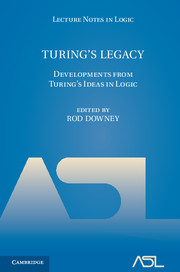Book contents
- Frontmatter
- Contents
- Turing's legacy: developments from Turing's ideas in logic
- Computability and analysis: the legacy of Alan Turing
- Alan Turing and the other theory of computation (expanded)
- Turing in Quantumland
- Computability theory, algorithmic randomness and Turing's anticipation
- Computable model theory
- Towards common-sense reasoning via conditional simulation: legacies of Turing in Artificial Intelligence
- Mathematics in the age of the Turing machine
- Turing and the development of computational complexity
- Turing machines to word problems
- Musings on Turing's Thesis
- Higher generalizations of the Turing Model
- Step by recursive step: Church's analysis of effective calculability
- Turing and the discovery of computability
- Transfinite machine models
- References
Computability and analysis: the legacy of Alan Turing
Published online by Cambridge University Press: 05 June 2014
- Frontmatter
- Contents
- Turing's legacy: developments from Turing's ideas in logic
- Computability and analysis: the legacy of Alan Turing
- Alan Turing and the other theory of computation (expanded)
- Turing in Quantumland
- Computability theory, algorithmic randomness and Turing's anticipation
- Computable model theory
- Towards common-sense reasoning via conditional simulation: legacies of Turing in Artificial Intelligence
- Mathematics in the age of the Turing machine
- Turing and the development of computational complexity
- Turing machines to word problems
- Musings on Turing's Thesis
- Higher generalizations of the Turing Model
- Step by recursive step: Church's analysis of effective calculability
- Turing and the discovery of computability
- Transfinite machine models
- References
Summary
§1. Introduction. For most of its history, mathematics was algorithmic in nature. The geometric claims in Euclid's Elements fall into two distinct categories: “problems,” which assert that a construction can be carried out to meet a given specification, and “theorems,” which assert that some property holds of a particular geometric configuration. For example, Proposition 10 of Book I reads “To bisect a given straight line.” Euclid's “proof” gives the construction, and ends with the (Greek equivalent of) Q.E.F., for quod erat faciendum, or “that which was to be done.” Proofs of theorems, in contrast, end with Q.E.D., for quod erat demonstrandum, or “that which was to be shown”; but even these typically involve the construction of auxiliary geometric objects in order to verify the claim.
Similarly, algebra was devoted to developing algorithms for solving equations. This outlook characterized the subject from its origins in ancient Egypt and Babylon, through the ninth century work of al-Khwarizmi, to the solutions to the quadratic and cubic equations in Cardano's Ars Magna of 1545, and to Lagrange's study of the quintic in his Réflexions sur la résolution algébrique des équations of 1770.
The theory of probability, which was born in an exchange of letters between Blaise Pascal and Pierre de Fermat in 1654 and developed further by Christian Huygens and Jakob Bernoulli, provided methods for calculating odds related to games of chance.
Information
- Type
- Chapter
- Information
- Turing's LegacyDevelopments from Turing's Ideas in Logic, pp. 1 - 47Publisher: Cambridge University PressPrint publication year: 2014
References
Accessibility standard: Unknown
Why this information is here
This section outlines the accessibility features of this content - including support for screen readers, full keyboard navigation and high-contrast display options. This may not be relevant for you.Accessibility Information
- 56
- Cited by
